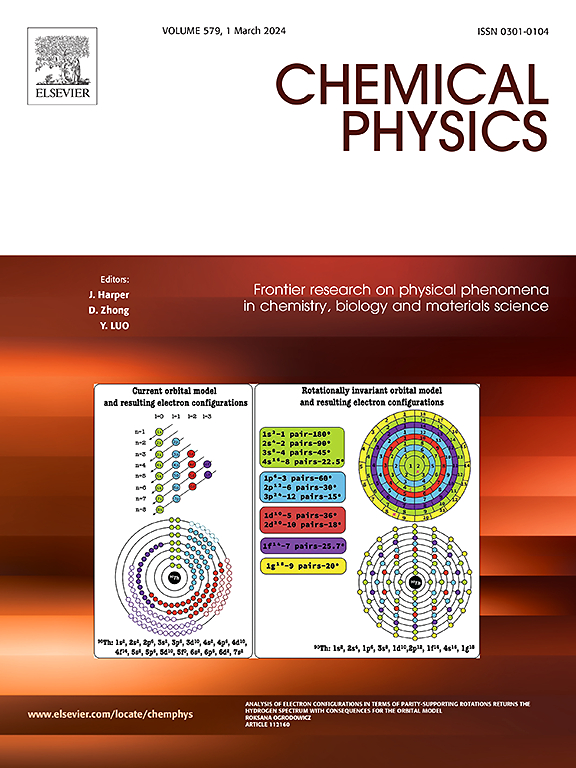First-principles study on crystal structure, mechanical thermodynamics, and electronic properties of perovskite energetic materials under high pressure
IF 2
3区 化学
Q4 CHEMISTRY, PHYSICAL
引用次数: 0
Abstract
Based on first-principles calculations, the (H2dabco)[NH2NH3(ClO4)3] (DAP-7) compound was studied in depth using the dispersion-corrected density functional theory (DFT![]() D) method, and the influence of pressure on its impact sensitivity and stability was evaluated. Analysis of the characteristic bond angles and torsion angles within the crystal revealed that at 11 GPa, the skeleton structure of the A-site cation H2dabco2+ became distorted. The calculated average fractional coordinates and Euler angles of the centroids for the A-site and X-site structures structures showed that throughout the entire pressure range, the crystal only underwent a slight rotational transformation with the space group remaining unchanged. According to the first-principles band gap criterion and the trend of bandgap changes under different pressures, it was found that around 25 GPa, the decrease in the bandgap value of DAP-7 changed significantly. Additionally, the elastic constants (Cij), elastic moduli (B, E, G), and Cauchy pressure (C12-C44) all increased with increasing pressure, indicating that the rigidity and ductility of the crystal are significantly enhanced under pressure. The calculation results of intermolecular interactions showed that the largest proportion of total interaction is hydrogen bonding H⋯O(O⋯H), which decreases as pressure increases, thus leading to an increase of impact sensitivity of materials.
D) method, and the influence of pressure on its impact sensitivity and stability was evaluated. Analysis of the characteristic bond angles and torsion angles within the crystal revealed that at 11 GPa, the skeleton structure of the A-site cation H2dabco2+ became distorted. The calculated average fractional coordinates and Euler angles of the centroids for the A-site and X-site structures structures showed that throughout the entire pressure range, the crystal only underwent a slight rotational transformation with the space group remaining unchanged. According to the first-principles band gap criterion and the trend of bandgap changes under different pressures, it was found that around 25 GPa, the decrease in the bandgap value of DAP-7 changed significantly. Additionally, the elastic constants (Cij), elastic moduli (B, E, G), and Cauchy pressure (C12-C44) all increased with increasing pressure, indicating that the rigidity and ductility of the crystal are significantly enhanced under pressure. The calculation results of intermolecular interactions showed that the largest proportion of total interaction is hydrogen bonding H⋯O(O⋯H), which decreases as pressure increases, thus leading to an increase of impact sensitivity of materials.

高压条件下钙钛矿含能材料晶体结构、力学热力学和电子性能的第一性原理研究
基于第一性原理计算,采用分散度校正密度泛函理论(DFTD)方法对(H2dabco)[NH2NH3(ClO4)3] (DAP-7)化合物进行了深入研究,并评价了压力对其冲击敏感性和稳定性的影响。对晶体内部的特征键角和扭角分析表明,在11 GPa时,a位阳离子H2dabco2+的骨架结构发生畸变。计算得到的a位和x位结构质心的平均分数坐标和欧拉角表明,在整个压力范围内,晶体只发生了轻微的旋转变换,空间群保持不变。根据第一线原理带隙判据和不同压力下带隙的变化趋势,发现在25 GPa左右,DAP-7的带隙值下降幅度明显。弹性常数(Cij)、弹性模量(B、E、G)和柯西压力(C12-C44)均随压力的增大而增大,表明在压力作用下晶体的刚性和延展性得到了显著增强。分子间相互作用的计算结果表明,总相互作用中最大的比例是氢键H⋯O(O⋯H),它随着压力的增加而减小,从而导致材料的冲击敏感性增加。
本文章由计算机程序翻译,如有差异,请以英文原文为准。
求助全文
约1分钟内获得全文
求助全文
来源期刊

Chemical Physics
化学-物理:原子、分子和化学物理
CiteScore
4.60
自引率
4.30%
发文量
278
审稿时长
39 days
期刊介绍:
Chemical Physics publishes experimental and theoretical papers on all aspects of chemical physics. In this journal, experiments are related to theory, and in turn theoretical papers are related to present or future experiments. Subjects covered include: spectroscopy and molecular structure, interacting systems, relaxation phenomena, biological systems, materials, fundamental problems in molecular reactivity, molecular quantum theory and statistical mechanics. Computational chemistry studies of routine character are not appropriate for this journal.
 求助内容:
求助内容: 应助结果提醒方式:
应助结果提醒方式:


